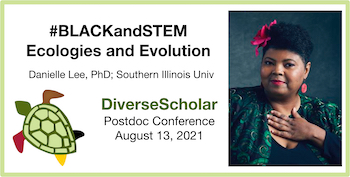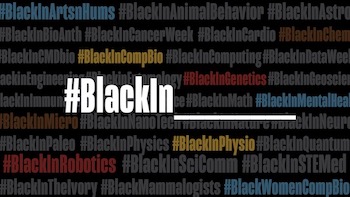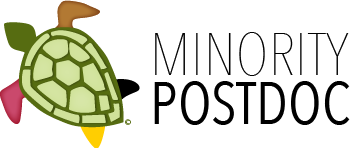Clinton Parks and Alberto I. Roca, Ph.D.
Reporting on the #DivSch21 Lee plenary session.
Science has entered a new phase. No longer the exclusive sphere of white (and sometimes Asian) men, science is more inclusive to people of varying gender, nationality, ethnicity, and sexual orientation. That's not to suggest it has reached some post-racial, post-feminist ideal, only that it is more equitable.
 Much of that is due to the way younger, often Black and brown, scientists are talking about what they do. Many are eschewing how science had been traditionally communicated. It's become more open, more inclusive, and more transparent. Furthermore, many of these early career researchers are bringing their whole selves to their professions, not satisfied with letting just their work speak for them. Instead, they are using social media online and other means to voice their opinions and speak up, about more than just science.
Much of that is due to the way younger, often Black and brown, scientists are talking about what they do. Many are eschewing how science had been traditionally communicated. It's become more open, more inclusive, and more transparent. Furthermore, many of these early career researchers are bringing their whole selves to their professions, not satisfied with letting just their work speak for them. Instead, they are using social media online and other means to voice their opinions and speak up, about more than just science.
Pioneer Danielle Lee, PhD
Among the first of these scientists in the mid-2000s was Danielle Lee, PhD. In the lab, she is an ecologist and, more specifically, a mammologist at Southern Illinois University at Edwardsville. She calls herself a scientist communicator as a professional researcher who also talks about the discipline. Performing science communication (SciComm) well to the public is not a criteria; but, it enhances one's career, she said during a keynote presentation at the 2021 DiverseScholar Postdoctoral Conference. Lee's presentation was about how the convergence of communities of color, Black and brown scientists, and the socioeconomic justice movement came to be in her talk titled “#BLACKandSTEM Ecologies and Evolution”.
She was there at the beginning, in the primordial soup (as she calls it), around 2002, when Black and brown scientists began connecting with one another and to the public through their website blogs. Many communicators were PhD graduate students such as Lee who was training at the University of Missouri - St. Louis. This time was when marginalized scientists could connect with one another and share their work, news, and professional interests via an informal online medium — outside of talks, forums, and peer-reviewed papers. The “Blogging While Brown" about science community included Black and Latinx researchers who communicated STEM to their people, she said. For the first time, lay folk “were able to interact directly with scientists and researchers,” according to Lee. Before this there were only articles accessible through physical journals or an online paywall as well as through intermediaries such as science journalists.
Blog carnivals and social media for STEM diversity
A big part of this online interaction were “carnivals,” which were themed events in which bloggers placed content in a magazine-style format. The Diversity in Science Carnival involved socioeconomic, race, LGBTQ, and issues of intersectionality [Roca & Yoder 2011]. Many of the participating graduate students and postdocs began by advocating for diversity at their home institutions. During Black History month, submissions about Black achievements in science, Black science mentorship, and the like were reviewed, edited, and then curated into a collection [for example Lee 2009]. Lee's blogging experience encompassed various online communities. Beyond science, she engaged in blog writing about education, nature, Black experience, women, and parenting.
The ability to network with other scientists of color was exciting. They were few, far apart, and mostly unknown to one another. The electricity extended throughout the larger SciComm community. Traditional science publishers, including, AAAS, Discover, Nature, and Scientific American, backed some of these online efforts. Yet, many Black and brown bloggers hid their identities to shield themselves from potential professional backlash at their universities.
An example Lee gave of the caution used is the Micella Phoenix DeWhyse blog, which was hosted on AAAS' Science Careers website. The eponymous Micella only identified herself as a woman of color who worked in science. At the time, the blog writer Dr Ticora V. Jones, was so careful not to out herself that she did not even identify herself as a Black woman [Jones 2020]. “Blogging was not well received by many of the most formal institutions,” Lee said. “I was repeatedly asked why I was doing this, with the implication [being] that I was wasting my time and thus distracting myself professionally — I should be focused on things like my primary research.”
#BLACKandSTEM, #BlackInSTEM, and more
Anonymity largely disappeared with the next online platform. Around 2009, the blogosphere evolved into the Twittersphere. Twitter enabled short-form, more targeted, more connected social media, according to Lee. In 2014, Dr. Stephani Page (@ThePurplePage), then a grad student at the University of North Carolina at Chapel Hill School of Medicine, changed the game with her “#BLACKandSTEM what do you do?” Tweet [Zax 2014]. With that, she helped to create a movement and galvanize a community of Black scientists. Often used in conjunction with or in accordance with the aforementioned hashtag is #BlackInSTEM. The latter was also first used as roll call for the Black science community by Esther Odekunle (@EstOdek) in August 2019. But in May 2020, the British antibody engineer at GSK made the hashtag into a formal movement [Odekunle 2020].
social media gave us the opportunity to find each other
This also enabled the creation of offshoot communities with more focused identities and personal interests. For scientists working or studying at historically Black colleges, @HBCUSTEM was created in November 2014. Dartmouth professor of astrophysics, Jedidah Isler (@JedidahIslerPhD), began #VanguardSTEM in June 2015 as a place to for feminist-empowered researchers, especially women of color and nonbinary individuals [Isler et al 2021]. Similarly, #STEMNoire focuses on Black women in STEM. @WokeSTEM began in September 2017 by advocating for a decolonizationist mentality in the science community. As someone who sometimes works in Africa, Lee started #AfricanSTEM in May 2015. African researchers working in the U.K. started #AfricansInSTEM in March 2019.
Perhaps, more importantly, these new affinity groups have enabled the creation of what Lee calls “back channels.” In other words, these largely virtual communities led to informal, in-person gatherings at diversity conferences, like SACNAS, and at technical conferences, like Animal Behavior. #STEMNoire hosts a conference focused on the well-being of its attendees as whole persons, not just as scientists. #VanguardSTEM uses “conference crashing” and “guerrilla mentoring” to create physical spaces of comfort for Black, brown, and Indigenous women, and nonbinary people in attendance.
The formalization of these communities was “important because for so many of us, we were all scattered,” Lee said. “We were often 'lonely onlys' in our programs and often at our institutions. And so, social media gave us the opportunity to find each other, make friends, find mentors and support systems that existed at least virtually — even if we didn't have it physically at our own institutions and departments.” And it's how Lee found her cohort of like-minded scientists of color: those who also sought social justice and Black liberation.
These Twitter-born communities are still ongoing [Gewin 2021]. But those communities sometimes exist in multiple platforms. In 2018, Instagram provided better interactivity and more of an audiovisual focus for participants. And like biological evolution, Lee believes that we are now in a time when communities of scientists of color have branched and exploded rapidly to suit various niche environments. To complete the metaphor, she calls this the age of rapid radiation, which started in 2020.
 This explosion had a spark: #BlackBirdersWeek. It was a reaction to violence against Black professionals and hobbyists in outdoor spaces. The specific incident was when Amy Cooper, a white woman, threatened Christian Cooper, a Black man who was birding, with police violence in New York City's Central Park [Mallenbaum 2020]. “Nearly a hundred, mostly Black, graduate students with some undergraduate students and a couple of postdocs came together immediately in response,” according to Lee. This marked a turning point in which Black scientists would no longer compromise themselves, their people, and their values for the sake of their jobs or the broader science community.
This explosion had a spark: #BlackBirdersWeek. It was a reaction to violence against Black professionals and hobbyists in outdoor spaces. The specific incident was when Amy Cooper, a white woman, threatened Christian Cooper, a Black man who was birding, with police violence in New York City's Central Park [Mallenbaum 2020]. “Nearly a hundred, mostly Black, graduate students with some undergraduate students and a couple of postdocs came together immediately in response,” according to Lee. This marked a turning point in which Black scientists would no longer compromise themselves, their people, and their values for the sake of their jobs or the broader science community.
The end result is what Lee calls the #BlackinX period. The “X” being the variable of a given community. “That created dozens, perhaps hundreds of themed weeks,” she said. “It created this rolling jubilee of hashtags communities” of themes and disciplines — from birders to oncologists, botanists to engineers. The MinorityPostdoc career portal maintains a roster of these emerging affinity groups. Change also came in how these communities come together. They are now quickly assembled, well-organized events. These are wide-ranging engagement and participation — multiracial, multilevel professionally, multigenerational events organized for social justice and change-making — which creates the intersection of science and advocacy that has taken hold.
Roster of #BlackInSTEM and more affinity groups
Gewin V (2021) The hashtags that brought Black scientists together, Nature, August 16
Isler JC, Berryman NV, Harriot A, Vilfranc CL, Carrington LJ, & Lee DN (2021) Defining the Flow: Using an Intersectional Scientific Methodology to Construct a VanguardSTEM Hyperspace, Genealogy 5:8
Jones TV (2020) I Wrote My Way Out - Micella Phoenix DeWhyse Revealed. DiverseScholar 11:1
Lee DN (2009) Diversity in Science #1: Black History Month Celebration, Urban Science Adventures!, Feb 24
Mallenbaum C (2020) #BlackBirdersWeek, #BlackInNeuro: Black scientists, physicians are using hashtags to uplift, USA Today, August 4
Odekunle E (2020) I created a moment..., Twitter, May 30
Roca AI & Yoder JB (2011) Online LGBT Pride: Diversity in Science Blog Carnival. DiverseScholar 2:1
Zax D (2014) #BLACKandSTEM: The Hashtag as Community, Fast Company, March 4
(top) DivSch21 plenary flyer. (Credit: A.I. Roca)
(bottom) BlackInSTEM collage. (Credit: S. Taylor for DiverseScholar)
C. Parks & A.I. Roca (2023) Danielle Lee on the Origins and Growth of #BLACKandSTEM. DiverseScholar 14:1
Clinton Parks is a Washington, DC-based freelance science writer who has written for AAAS' ScienceCareers, the American Chemical Society's Axial, and the American Physical Society's Physics Buzz, among others. Alberto I. Roca, Ph.D. is the Founder and Editor of MinorityPostdoc.org. Any opinions expressed in this article are solely those of the authors.
Editor's note: DiverseScholar is now publishing original written works. Submit article ideas by contacting us at info@DiverseScholar.org.
Originally published 24-December-2023
